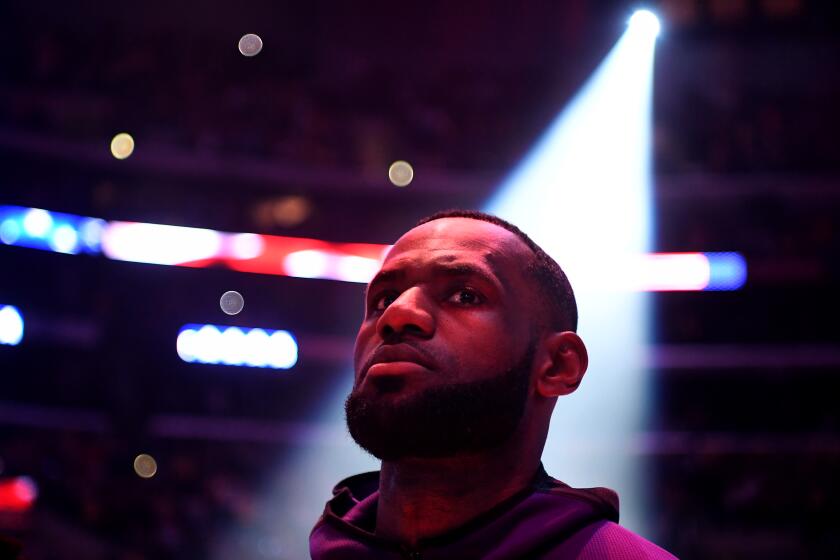Athletes turn to technology to give their eyes the edge
- Share via
Any sport that uses a ball has a universal rule: Keep your eye on the ball at all times. A football is thrown and, if the receiver takes his eyes off the ball, the catch is not made. A baseball is thrown and, if a player loses focus for a split-second and the pitch is a strike, he can be out.
Seemingly, the eyes are the most important tool an athlete has. Often, it is the most overlooked. There are all types of training, from strength to endurance, but what about vision? Look no further than the sea of new 3-D and virtual technologies that not only strengthen an athlete’s vision, but also cure vision impairments due to injuries.
“Along with weight training and good nutrition, vision has taken a role in the athletes training,” said Dr. Barry Seiller, owner of Vizual Edge, an internet-based 3-D visual-training system.
“It’s not just eyesight. Eyesight is the basis ... it’s depth perception, your ability to track an object. All of those together make a harmonious vision system (which) allows you to process information more quickly.”
Eyesight is composed of separate images gathered from the right and left eye. The visual cortex, located in the brain, combines those images creating basic sight. That image is two-dimensional (flat). The eye enhances the image making it three-dimensional by adding depth, peripheral and motion views.
“This software is aimed to improve the ability for someone to use the right and left eye better together,” said Dr. Nathan Steinhafel from the Pediatric and Adult Vision Care in Wexford. “(Some) may simply want to improve their sports performance.
“They want to improve their visual reaction time, eye tracking, convergence skills and be more aware of ... the finer points of our depth perception.”
Three-dimensional systems, such as Vizual Edge, look to train three aspects of vision.
Saccadic movement, which means moving the eye from point A to point B, like finding an available receiver on the field. Pursuant movement, which means tracking an object, like a soccer ball. And last, vergence movement that includes converging, having the eyes focus on something moving closer, like a fastball, and diverging, having the eyes focus on something moving further away, like the accuracy of a throw.
“Superior athletes describe their play and say it moves slower for them because they are processing the information more accurately,” Seiller said.
The virtual-reality systems, such as the equipment used by the Tampa Bay Buccaneers and Dallas Cowboys, test the same aspects of vision but in a simulated setting.
Players wear a headpiece, which records their perspectives of the field and shows the player a live playbook for their team and the opposing team. The tape is viewable afterwards, to see what was missed and if there were better options.
“I recommend (these programs) to any athlete who is looking to improve visual performance (and) any athlete who is going through a concussion and suffering from binocular vision dysfunction. In addition to other prescribe therapies,” Steinhafal said.
Concussion patients often have visual impairments due to the injury, such as double vision, vision field loss (peripheral vision), or poor eye tracking. Since the programs are geared toward these ailments, according to Steinhafal, concussion patients who can use the program have a high success rate of improvement.
One patient of Seiller’s who has used Vizual Edge is former Chicago Cubs outfielder Adam Greenberg, who was struck in the back of his head with a pitch in 2005. That was his first appearance at the plate, and he suffered a mild concussion. Afterwards, his career wasn’t the same and Greenberg was not sure why. Greenberg was introduced to Seiller’s program and soon realized the problem was his vision.
“With vision (problems), you look fine and feel fine. You would never know if something was wrong,” Greenberg said. “I wasn’t crazy. I worked hard that season, and it wasn’t panning out because of my eyes.”
Greenberg suffered from binocular vision ailments caused from the concussion that sparked convergence issues and poor tracking. He said the Vizual Edge system helped him cure some of these ailments.
“Concussions (happen) everywhere and, when there is something that can help. It’s great,” he said.
At Steinhafal’s office, patient’s are seen once a week or once every two weeks depending on their schedules and their commute to the office. They come to the office to use 3-D technology and other basic therapies such as a lighting board where patients will follow and touch the spaces that light up, wack-a-mole style.
The program used at the office is similar to Vizual Edge, but uses video-game controllers, instead of a mouse. Patients also are given the program and other activities to complete at home.
Gunnar Kovell, 13, suffered a concussion playing rugby. On his second appointment, he said he could see a difference in his vision with the programs help.
“I would say the success rate (for the program) is very high. I have never seen anyone who hasn’t gotten better in some way,” said Karen Vaina, a vision therapist.
(c)2015 Pittsburgh Post-Gazette
Visit the Pittsburgh Post-Gazette at www.post-gazette.com
Distributed by Tribune Content Agency, LLC.
More to Read
Go beyond the scoreboard
Get the latest on L.A.'s teams in the daily Sports Report newsletter.
You may occasionally receive promotional content from the Los Angeles Times.










